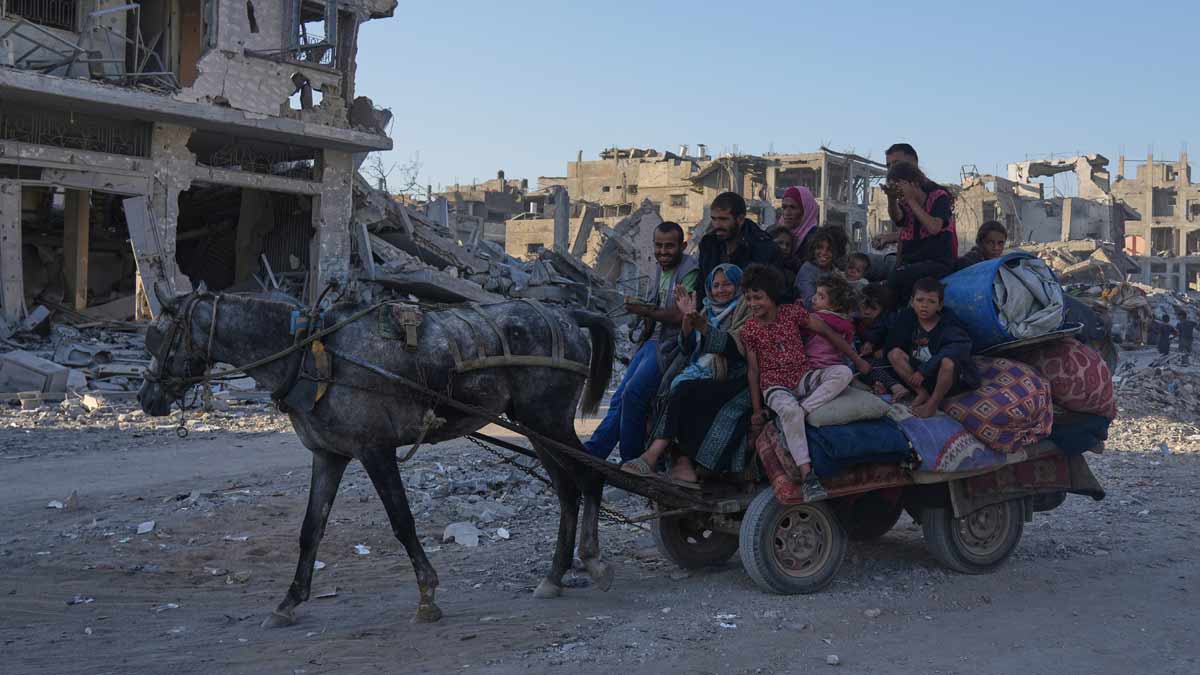Gaza ceasefire: Displaced Palestinians return to devastated homes
 Displaced Palestinians ride on a horse-drawn cart loaded with belongings as they pass along the heavily damaged Al-Jalaa Street in Gaza City | AP/PTI
Displaced Palestinians ride on a horse-drawn cart loaded with belongings as they pass along the heavily damaged Al-Jalaa Street in Gaza City | AP/PTI
Tens of thousands of displaced Palestinians have begun returning to what remains of their homes in Gaza following the start of a fragile ceasefire between Hamas and Israel. The truce, which came into effect at midday yesterday, offers the first genuine pause in violence since March, bringing a moment of respite to a population battered by months of relentless conflict.
Israeli forces withdrew from several key areas last morning, moving to positions agreed upon as part of the ceasefire arrangement. The IDF announced that troops are now stationed at “updated deployment lines in preparation for the ceasefire agreement and the return of hostages."The next key part is the exchange of hostages and prisoners. Under the agreement, Hamas will have 72 hours to release all hostages, including the bodies of those who have died. Israel, in return, will free 250 Palestinian prisoners serving long sentences in Israeli prisons and also around 2,000 Gazans arrested during the war, including minors who were not involved in the October 7 attacks.
The scale of displacement has been immense. It is believed that up to 90 percent of Gaza City's residents fled during the conflict. On the first day of Israel’s partial pullback, around 200,000 people made their way back to northern Gaza. For many, it is not the first attempt to return, as previous ceasefires were short-lived and marked by renewed fighting.
With roads, bridges and other infrastructure damaged, most Gazans are forced to walk over 20 km, carrying whatever they have managed to save. Those unable to walk face exorbitant transport costs, with vehicle hire reportedly costing as much as 4,000 shekels (around $ 1,200)– a price far beyond the reach of most. Aid groups and witnesses describe returnees as physically weakened, malnourished and emotionally drained, bearing the visible toll of conflict and displacement.
What awaits them is devastation on a vast scale. Gaza City, once the territory’s bustling urban heart, has been reduced to ruins. Recent assessments suggest that nearly three quarters of the city's buildings have sustained damage. In neighbourhoods like Sheikh Radwan, Sabra and Zeitoun, entire residential blocks have been flattened. Same is the case in southern areas like Khan Younis, where entire neighbourhoods have been destroyed beyond recognition.
Basic infrastructure is virtually non-existent in the north. There is no electricity, no running water and no functioning sanitation. Humanitarian conditions remain dire. Aid agencies warn that food, fuel and clean water are in critically short supply, and a famine had already been declared in parts of Gaza months earlier.
Security remains a serious concern. The Israeli army has warned civilians to avoid areas such as Beit Hanoun, Beit Lahia and Shuja’iyya, which are deemed extremely dangerous. Though Israel has pulled back from some areas, it continues to control significant portions of Gaza and maintains the right to conduct military operations. In areas vacated by Israeli forces, armed Hamas fighters have been seen patrolling the streets, some wearing insignia of the group’s internal security agency. Their presence highlights the unresolved question of who will govern Gaza going forward, particularly in light of international proposals that seek to exclude Hamas from any future role.
According to a statement from Prime Minister Benjamin Netanyahu’s office, the Israeli military will complete its redeployment by today. Notwithstanding the ceasefire, Netanyahu made clear that the war could resume if Hamas refuses to disarm, stating that Gaza will be demilitarised, one way or another. President Donald Trump, meanwhile, is expected to fly to Israel on October 13, and deliver an address to the parliament, the Knesset.
Middle East